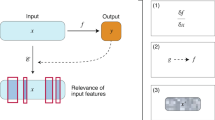Abstract
Artificial intelligency can bring speed and reliability to drug discovery process. It represents an additional intelligence, which in any case can replace the strategic and logic creative insight of the medicinal chemist who remains the architect and molecule master designer. In terms of drug design, artificial intelligency, deep learning machines, and other revolutionary technologies will match with the medicinal chemist’s natural intelligency, but for sure never go beyond. This manuscript tries to assess the impact of the artificial intelligency on drug discovery today.
Similar content being viewed by others
References
Armstrong RW, Beau J-M, Cheon SH, Christ WJ, Fujioka H, Ham WH, Hawkins LD, Jin H, Kang SH (2009) Total synthesis of palytoxin carboxylic acid and palytoxin amide. J Am Chem Soc 111:7530–7533. https://doi.org/10.1021/ja00201a038
Baenninger A (2004) Good chemistry: the life and legacy of valium inventor Leo Sternbach. McGraw-Hill, New York. ISBN 0-07-142617-5
Chanteau SH, Tour JM (2003) Synthesis of anthropomorphic molecules: the Nanoputians. J Org Chem 68(23):8750–8766. https://doi.org/10.1021/jo0349227)
Donderwinkel SH, Van Hest JCM, Cameron NR (2017) Bio-inks for 3D bioprinting: recent advances and future prospects. Polym Chem 31:4451–4471. https://doi.org/10.1039/c7py00826k
Drug Development and Delivery (2018) Artificial intelligence—3Ds powering AI in drug discovery—domain expertise, deep learning and data, BenchBlog. https://blog.benchsci.com. Accessed 7 Aug 2018
Fink T, Reymond J-L (2007) Virtual exploration of the chemical universe up to 11 atoms of C, N, O, F: assembly if 26.4 million structures (110.9 million stereoisomers) and analysis for new ring systems, stereochemistry, physicochemical properties, compound classes and drug discovery. J Chem Inf Model 47:342–353. https://doi.org/10.1021/ci600423u
Gordon RT (2016) The rise and fall of American growth: the U.S. standard of living since the Civil War. Princeton University Press, Princeton, ISBN 9780691175805
Hover BM, Kim SH, Katz M, Charlop-Powers Z, Owen JG, Ternei MA, Maniko J, Estrela AB, Molina H, Park S, Perlin DS, Brady SF (2018) Culture-independent discovery of the malacidins as calcium-dependent antibiotics with activity against multidrug-resistant Gram-positive pathogens. Nat Microbiol 3(4):415–422. https://doi.org/10.1038/s41564-018-0110-1
Kimura H, Sakai Y, Fujii T (2018) Organ/body-on-a-chip based on microfluidic technology for drug discovery. Drug Metab Pharmacokinet 33:43–48
Ling LL, Schneider T, Peoples AJ, Spoering AL, Engels I, Conlon BP, Mueller A, Schäberle TF, Hughes DE, Epstein S, Jones M, Lazarides L, Steadman VA, Cohen DR, Felix CR, Fetterman KA, Millett WP, Nitti AG, Zullo AM, Chen C, Lewis K (2015) A new antibiotic kills pathogens without detectable resistance. Nature 517:455–459. https://doi.org/10.1038/nature14098
Olgac A, Türe A, Olgac S, Möller S (2019) Cloud based high throughput virtual screening in novel drug discovery. In: Kolodziej J, Gonzalez-Velez H (eds) Springer Open, pp 250–278. ISSN 0302.9703. https://doi.org/10.1007/978-3-030-16272-6_9
Reymond J-L (2015) The chemical space project. Acc Chem Res 48:722–730. https://doi.org/10.1021/ar500432k
Acknowledgements
Institut de Biologie du Développement de Marseille (IBDM), Aix Marseille University and CNRS-UMR 7288 are greatly acknowledged for their financial support. We thank Mrs. Mair Richards for the manuscript’s English revision.
Curmudgeon Corner
Curmudgeon Corner is a short opinionated column on trends in technology, arts, science and society, commenting on issues of concern to the research community and wider society. Whilst the drive for super-human intelligence promotes potential benefits to wider society, it also raises deep concerns of existential risk, thereby highlighting the need for an ongoing conversation between technology and society. At the core of Curmudgeon concern is the question: What is it to be human in the age of the AI machine? -Editor.
Author information
Authors and Affiliations
Corresponding author
Additional information
Publisher's Note
Springer Nature remains neutral with regard to jurisdictional claims in published maps and institutional affiliations.
Rights and permissions
About this article
Cite this article
Kraus, Jl. Can artificial intelligency revolutionize drug discovery?. AI & Soc 35, 501–504 (2020). https://doi.org/10.1007/s00146-019-00892-0
Received:
Accepted:
Published:
Issue Date:
DOI: https://doi.org/10.1007/s00146-019-00892-0




